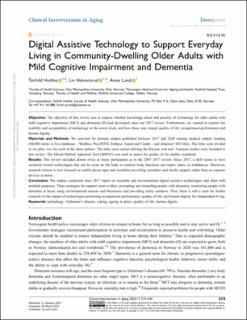| dc.contributor.author | Holthe, Torhild | |
| dc.contributor.author | Halvorsrud, Liv Torill | |
| dc.contributor.author | Lund, Anne | |
| dc.coverage.spatial | Norway | en_US |
| dc.date.accessioned | 2022-04-22T08:56:51Z | |
| dc.date.available | 2022-04-22T08:56:51Z | |
| dc.date.created | 2022-04-20T15:37:36Z | |
| dc.date.issued | 2022 | |
| dc.identifier.issn | 1176-9092 | |
| dc.identifier.uri | https://hdl.handle.net/11250/2992175 | |
| dc.description.abstract | Objective: The objective of this review was to explore whether knowledge about and practice of technology for older adults with
mild cognitive impairment (MCI) and dementia (D) had developed since our 2017 review. Furthermore, we wanted to explore the
usability and acceptability of technology in the newer trials, and how these may impact quality of life, occupational performance and
human dignity.
Materials and Methods: We searched for primary studies published between 2017 and 2020 reusing medical subject heading
(MeSH) terms in five databases – Medline, PsycINFO, Embase, Amed and Cinahl – and obtained 1452 titles. The titles were divided
in six piles, two for each of the three authors. The titles were sorted utilizing the Rayyan web tool. Fourteen studies were included in
this review. The Mixed Method Appraisal Tool (MMAT) was used to assess the quality of the studies examined.
Results: This review included almost twice as many participants as in the 2007–2017 review. Since 2017, a shift seems to have
occurred toward technologies that can be worn on the body to monitor body functions and report states, or imbalances. Moreover,
research interest is now focused on mobile phone apps and wearables providing reminders and timely support, rather than on separate
devices at home.
Conclusion: The studies conducted since 2017 report on wearable and environmental digital assistive technologies and often with
multiple purposes. Three strategies for support seem evident: prompting and reminding people with dementia, monitoring people with
dementia at home using environmental sensors and biosensors and providing safety outdoors. Thus, there is still a need for further
research on the impact of technologies promoting occupational performance, quality of life, and human dignity for independent living. | en_US |
| dc.language.iso | eng | en_US |
| dc.publisher | Dove Press | en_US |
| dc.relation.ispartofseries | Clinical Interventions in Aging;Volume 2022:17 | |
| dc.rights | Navngivelse-Ikkekommersiell 4.0 Internasjonal | * |
| dc.rights.uri | http://creativecommons.org/licenses/by-nc/4.0/deed.no | * |
| dc.subject | Assitive technology | en_US |
| dc.subject | Alzheimer's disease | en_US |
| dc.subject | Coping | en_US |
| dc.subject | Ageing in place | en_US |
| dc.subject | Quality of life | en_US |
| dc.subject | Human dignity | en_US |
| dc.title | Digital Assistive Technology to Support Everyday Living in Community-Dwelling Older Adults with Mild Cognitive Impairment and Dementia | en_US |
| dc.type | Peer reviewed | en_US |
| dc.type | Journal article | en_US |
| dc.description.version | publishedVersion | en_US |
| dc.rights.holder | © 2022 Holthe et al. | en_US |
| cristin.ispublished | true | |
| cristin.fulltext | original | |
| cristin.qualitycode | 1 | |
| dc.identifier.doi | https://doi.org/10.2147/CIA.S357860 | |
| dc.identifier.cristin | 2017956 | |
| dc.source.journal | Clinical Interventions in Aging | en_US |
| dc.source.volume | 17 | en_US |
| dc.source.issue | 17 | en_US |
| dc.source.pagenumber | 519-544 | en_US |

